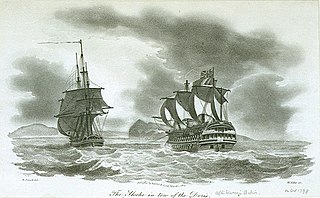
HMS Babet was a 20-gun sixth-rate post ship of the British Royal Navy. She had previously been a corvette of the French Navy under the name Babet, until her capture in 1794, during the French Revolutionary Wars. She served with the British, capturing several privateers and other vessels, and was at the Battle of Groix. She disappeared in the Caribbean in 1800, presumably having foundered.

HMS Goliath was a 74-gun third-rate ship of the line in the Royal Navy. She was built by Adam Hayes at Deptford Dockyard and launched on 19 October 1781. She was present at the Battle of Cape St Vincent, Battle of the Nile, and Battle of Copenhagen. She was broken up in 1815.
Launched on 21 May 1797, GB No. 21 was renamed HMS Defender on 7 August the same year. She was a 12-gun Courser-class gun-brig built for the British Royal Navy at Limehouse and disposed of in 1802.

HMS Doris was a 36-gun fifth-rate frigate of the Royal Navy, launched on 31 August 1795. which saw service in the French Revolutionary and Napoleonic Wars. Doris was built by Cleveley, of Gravesend.
HMS Atalante was a 16-gun brig-sloop of the Royal Navy. She was formerly the French Atalante, captured in 1797. She served with the British during the French Revolutionary and Napoleonic Wars, and was wrecked in 1807.

HMS Hornet was a 16-gun ship-rigged sloop of the Cormorant class in the Royal Navy, ordered 18 February 1793, built by Marmaduke Stalkart and launched 3 February 1794 at Rotherhithe. Hornet saw most of her active duty during the French Revolutionary Wars. During the Napoleonic Wars she served for about six years as a hospital ship before being laid up in 1811 and sold in 1817.
HMS Alcmene was a 32-gun Alcmene-class fifth rate of the Royal Navy. This frigate served during the French Revolutionary and Napoleonic Wars under the command of several notable officers. Alcmene was active in several theatres of the war, spending most of her time cruising in search of enemy vessels or privateers, and escorting convoys. She fought at the Battle of Copenhagen in 1801 and served in the blockade of the French coasts during the later Napoleonic Wars until she was wrecked on the French coast in 1809.

HMS Circe was a 28-gun Enterprise-class sixth-rate frigate of the Royal Navy. She was launched in 1785 but not completed or commissioned until 1790. She then served in the English Channel on the blockade of French ports before she was wrecked in 1803.
HMS Dolphin was 10-gun cutter that served the Royal Navy from 1793 to 1802, first as a hired armed cutter, and then after the Navy purchased her, as HMS Dolphin. During her almost decade of service Dolphin patrolled the English Channel protecting British trade by capturing French privateers and recapturing their prizes.
His Majesty's hired armed cutter Diligent served the British Royal Navy during the French Revolutionary Wars. She was a small vessel, of 44 tons (bm) and six 2-pounder guns, and she served from 27 February 1793 to 1 November 1801.

HMS Swallow was an 18-gun Albatross-class brig-sloop of the British Royal Navy, launched in 1795 and sold in 1802. During her naval career she captured a number of French privateers while on the Jamaica station. After her sale she became an armed whaler sailing under a letter of marque. As a privateer she captured two French whaling vessels but then is no longer listed after 1810.
Quatre frères was either American or Bermudian built vessel and commissioned in 1796 at Bordeaux as a French privateer. The Royal Navy captured her in April 1797 and took her into service as HMS Transfer. The Royal Navy sold her at Malta in 1802 to Ottoman Tripolitania. The U.S. Navy captured her in 1804 and took her into service as USS Scourge. The U.S. Navy sold her in 1812.
HMS Sparkler was an Acute-class gunvessel launched in 1797 as GB No.7 and renamed HMS Sparkler in August 1797. She served the Royal Navy during the French Revolutionary Wars. The Navy sold her in 1802. She became a merchantman. In 1813 a French privateer captured her but the Royal Navy recaptured her shortly thereafter. She was wrecked in February 1814.
HMS Busy was launched in 1797 as the only member of her class of brig-sloops. She captured one French privateer and numerous small merchantmen, but spent most of her career escorting convoys to and from the West Indies. She foundered in 1807 while serving on the Halifax, Nova Scotia, station.
Between 1793 and 1805, five cutters served the British Royal Navy as hired armed vessels under the designation HM hired cutter Rose:
HMS Tigress was a Courser-class gun-brig built for the British Royal Navy at King's Lynn, and laid down in 1797 as GB No. 45; she was renamed Tigress on 7 August the same year. She was sold on 20 January 1802.
Ellis was a French prize, captured in 1797, possibly built that year also. Liverpool merchants purchased her. She made five complete voyages as a slave ship in the triangular trade carrying enslaved people from West Africa to the British West Indies. She was lost at sea on 23 April 1806 on her sixth voyage before she could take on any captives.
HMS Cracker was an Acute-class gunbrig, launched in 1797. She was sold in 1802.
El Corso was launched in Spain in 1791 as a naval brig. the British Royal Navy captured her in 1796 and took her into service as HMS Corso. She then served in the Mediterranean where she captured numerous small vessels, the great majority of which were merchant vessels. In 1802 she sailed to England. From July 1802 to her sale in September 1814 she served as a receiving ship.
HMS Tickler was launched in 1794 as a Conquest-class gunbrig. She was sold in 1802.





